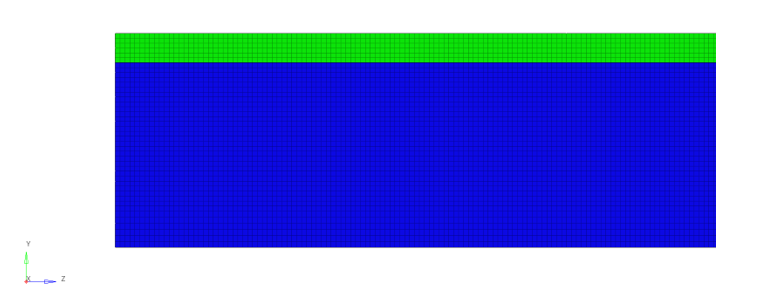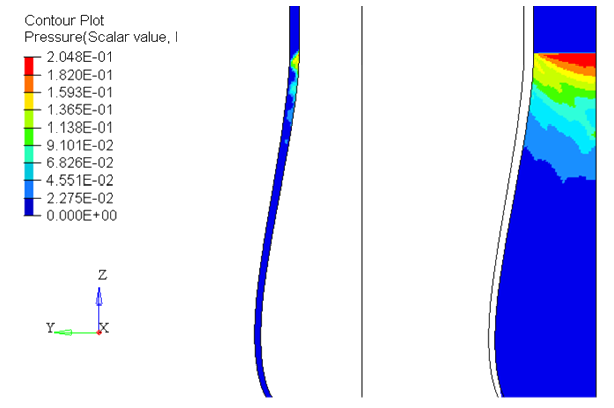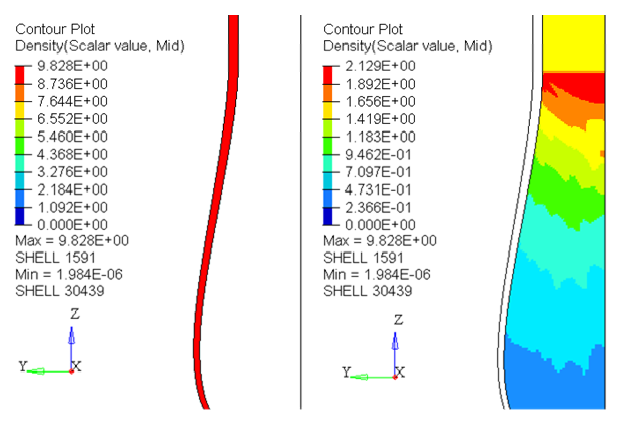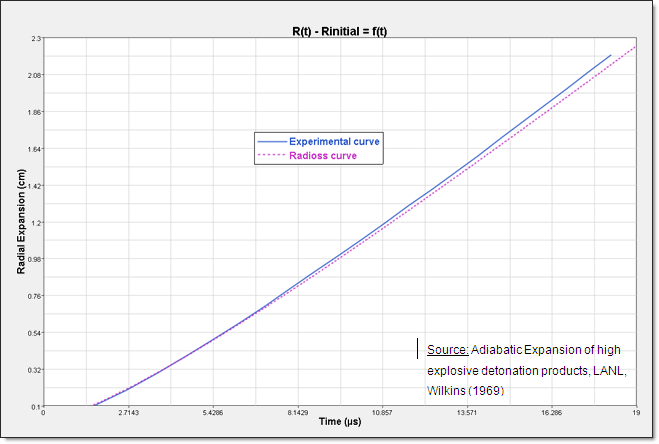RD-E: 4601 Lagrange Formulation
The purpose of this example is to show how to simulate the cylinder expansion test and compare the simulation result to experimental data.

Detonation is initiated at the bottom of the explosive. Radial expansion of the cylinder is measured and compared to experimental data.
- Axisymmetrical analysis (/ANALY)
- Lagrange formulation
- Quad elements
Options and Keywords Used
- Jones-Wilkins-Lee EOS (/MAT/LAW5 (JWL))
- Hydrodynamic Johnson-Cook Material (/MAT/LAW4 (HYD_JCOOK))
- Gruneisen equation of state (/EOS/GRUNEISEN)
- Solid property (/PROP/TYPE14 (SOLID))
- Boundary condition (/BCS)
- Detonation plan (/DFS/DETPLAN)
- Time history on node (/TH/NODE)
Input Files
Modeling Video
Model Description
A OFHC copper cylinder (1.53cm diameter, 0.26cm thickness, 30.5cm height) is filled with an explosive (TNT). Detonation is initiated at the bottom of the explosive. Radial expansion is measured at a length of 8*D cm.

Units: cm, s, g, Mbar
- Material Properties
- Value
- Initial density
- 1.63
- A
- 3.7121
- B
- 0.0323
- R1
- 4.15
- R2
- 0.95
- 0.3
- Detonation velocity D
- 0.693
- Chapman Jouguet pressure PCJ
- 0.21
- Detonation energy E0
- 0.07
#---1----|----2----|----3----|----4----|----5----|----6----|----7----|----8----|----9----|---10----|
/MAT/JWL/2
TNT
# RHO_I
1.63
# A B R1 R2 OMEGA
3.7121 .0323 4.15 .95 .3
# D P_CJ E0 Eadd I_BFRAC Q_OPT
.693 .21 .07 0 0 0
# P0 Psh B_un
0 0 0
#---1----|----2----|----3----|----4----|----5----|----6----|----7----|----8----|----9----|---10----|- Material Properties
- Value
- Initial density
- 8.96
- E-Module
- 1.24
- Poisson's ratio
- 0.35
- A
- 0.9e-3
- B
- 0.292e-2
- N
- 0.31
- 0.0066
- C
- 0.025
- 1e-5
- M
- 1.09
- 3.461e-3
- Tmelt
- 1656
- Material Properties
- Value
- C
- 0.394
- S1
- 1.489
- 1.97
- a
- 0.47
- E0
- 8.96
#---1----|----2----|----3----|----4----|----5----|----6----|----7----|----8----|----9----|---10----|
/MAT/HYD_JCOOK/1
Copper
# RHO_I
8.96
# E0 nu
1.24 .35
# A B n epsmax sigmax
.9E-03 .292E-02 .31 0 0.0066
# Pmin
-1.E30
# C EPS_DOT_0 M Tmelt Tmax
.25E-01 .1E-05 1.09 1656.0 1e30
# RHOCP Tr
3.461E-5 0
/EOS/GRUNEISEN/1
Copper
# C S1 S2 S3
.394 1.489 0 0
# GAMMA0 ALPHA E0 RHO_0
1.97 .47 0 8.96
#---1----|----2----|----3----|----4----|----5----|----6----|----7----|----8----|----9----|---10----|Model Method
A 2D axisymmetric mesh is made of Quad elements. The element size is approximately of 0.035 cm x 0.035 cm.

Boundary condition is set on the XZ plane at y = 0 (Tx = 0, Ty = 0) to ground the model.
A planar detonation wave is defined at the bottom of the cylinder.
In order to plot the curve of radial expansion, displacements of node ID 31240 z = 24.48 cm on the outer wall of the copper cylinder are saved in time history. It corresponds to L/D=8 in agreement with experimental protocol.
A scale factor of 0.5 (on time step for all elements) is used for this type of application.
In solid properties, qa and qb default values are used. These values have to be changed depending of the formulation (ALE, Euler).
#---1----|----2----|----3----|----4----|----5----|----6----|----7----|----8----|----9----|---10----|
/PROP/SOLID/2
TNT
# Isolid Ismstr Icpre Itetra10 Inpts Itetra4 Iframe dn
0 0 0 0 0 0 0 0
# q_a q_b h LAMBDA_V MU_V
0 0 0 0 0
# dt_min istrain IHKT
0 0 0
#---1----|----2----|----3----|----4----|----5----|----6----|----7----|----8----|----9----|---10----|#---1----|----2----|----3----|----4----|----5----|----6----|----7----|----8----|----9----|---10----|
/PROP/SOLID/1
Copper
# Isolid Ismstr Icpre Itetra10 Inpts Itetra4 Iframe dn
0 0 0 0 0 0 0 0
# q_a q_b h LAMBDA_V MU_V
0 0 0 0 0
# dt_min istrain IHKT
0 0 0
#---1----|----2----|----3----|----4----|----5----|----6----|----7----|----8----|----9----|---10----|Results
Curves and Animations



Conclusion
Good correlation between experimental and simulation results. A thinner meshing could improve the correlation between simulation and experimental curves.
Elapsed time for simulation: t = 11 441 s, 8514 cycles, (4 cpu intel core i7 Q 840 @ 1.87 GHz).
As the model is Lagrangian, the mesh becomes very distorted at the end of the simulation to obtain a proper mesh, it is possible to use the Euler method.